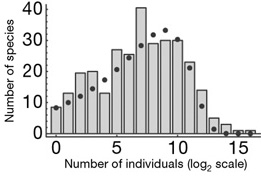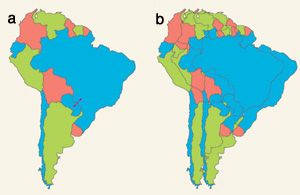

|
This month's topics:
The irregularly curved dumbbell relaxes
into a uniformly curved surface, in a 2-dimensional version
of the Ricci flow. The December 22 2006 issue of Science rates Grigori Perelman's Poincaré Conjecture proof the "Breakthrough of the Year," and celebrates it by printing Cameron Slayden's illustration of the Ricci flow on the cover of the magazine. Slayden shows us an example of the 2-dimensional analogue of the Ricci flow: the geometry of an irregularly curved dumbbell-like shape evolves to a constant-curvature spherical shape with the same topology. In the lead editorial Donald Kennedy, Science's Editor-in-chief, explains how the Breakthrough work "is very technical but has received unusual public attention" because (mostly) of that million-dollar prize. Kennedy's enthusiasm leads him slightly off track: "This story is rich with borrowings, from fluid mechanics, thermodynamics and even surgery!" Later in the issue is a nice, balanced account of the problem and the solution, by Dana Mackenzie. x e-x in a tropical rainforest "Dynamical evolution of ecosystems" ran in the December 14 2006 Nature. The authors, a team led by Jayanth Banavar (Penn State) and Amos Maritan (Padua), start their report with the sentence: "We present an analytical model that allows one to probe the characteristic timescales of evolving tropical forests and to evaluate the consequences of anthropogenic processes." In this and in a previous paper with a different team, Banavar and Maritan explore how density dependence (an effect that "disfavours the population growth of locally abundant species relative to uncommon species") impacts species diversity and relative species abundance (RSA). Here they show how a factor (b) representing density dependence fits into an analytic expression
 for the probability distribution function giving relative species abundance, and match their calculation with a measured RSA distribution: that of trees in the stand of tropical rain-forest maintained by the Smithsonian Institution on Barro Colorado Island, Panama. The analytic expression is calculated using a symmetric model in which the species are interchangeable; they have birth and death rates b(x) = b1x + p0, d(x) = d1x - p0, where b1 and d1 are the per-capita rates and p0 incorporates the density dependence. In the equation, τ = 1/(b1 - d1) is the characteristic timescale of the system (reflecting how fast the system returns to equilibrium after a perturbation); D = (b1 + d1)/2 "accounts for demographic stochasticity" and b = 2p0. The hairy coefficient is there to guarantee a total integral equal to 1. 
Relative species abundance for trees in the Barro Colorado Island forest from the 1990 census, compared with predictions (dots) from the expression given above. Individuals of more than 1 cm in diameter were counted. Image from Nature 444 926, used with permission.  Helaman at work, carving granite with a diamond-toothed chainsaw. Image reprinted with permission from Unger, Science 314:412 (2006). Photo by J. Moglia. © 2006 American Association for the Advancement of Science. "By refusing to choose between mathematics and art, a self-described 'misfit' has found the place where parallel careers meet." So runs the sub-heading for Katherine Unger's profile of Helaman Ferguson in the October 20 2006 issue of Science. "Misfit" seems hardly appropriate for Ferguson. His mathematical work has been prominently recognized (as Unger tells us, the "PSLQ" algorithm he devised with Rodney Forcade was named one of the top 10 algorithms of the 20th century) and he leads the world in creating scientifically inspired, viscerally appealing works of art. Unger takes us from Ferguson's early years in upstate New York (he was an apprentice stone-mason as a teen-ager) through graduate school (thesis in representation theory) and 17 years on the mathematics faculty at Brigham Young University; he "now devotes most of his time to his art." She quotes him on his love for working in granite: "Mathematics is kind of timeless, so incorporating mathematical themes and ideas into geologically old stone -- that's something that has great aesthetic appeal to me." The profile is illustrated with several pictures of his work; more here. "Proof at a roll of the dice." That's the title of a News and Views piece contributed by Bernard Chazelle (Computer Science, Princeton) to the December 28 2006 Nature. His subject is probabilistically checkable proof, or PCP: "the curious phenomenon that the mere ability to toss coins makes it possible to check the most complex of mathematical proofs at no more than a passing glance." The underlying theorem is about ten years old, and has recently been given an "elementary" proof ("the latest chapter in one of the most engrossing chronicles of computer science") by Irit Dinur (Hebrew University). Here is Chazelle's statement of the PCP Theorem: "any statement S whose validity can be ascertained by a proof P written over n bits also admits an alternative proof, Q. This proof Q has two appealing features: it can be derived from P in a number of steps proportional to nc, where c is some constant; and P can be verified by examining only three bits of Q picked at random. If S is true, a correct P will satisfy the verifier with a probability of 99%. If it is not true, any alleged proof P will trigger a rejection from Q with a probability higher than 50%." To suggest how P and Q are related, Chazelle has us imagine figure a below as P: a proof of the (false) statement that a map of South America can be colored with 3 colors so that no adjacent countries are colored the same. To check the validity of this proof one has to check all the boundaries of all the countries; eventually one finds that Brazil and Paraguay are colored the same. Q corresponds to the coloring b of the "smeared out" map on the right. Dinur's construction guarantees that if the first map is not 3-colorable, then b "will leave at least a fixed fraction of its edges monochromatic." And so a random probe has a good chance of detecting an error. Chazelle reminds us towards the end to "Keep in mind that this is all about verifying proofs, not about understanding them--with only three bits!--let alone discovering them. That must still be done the hard way." 
The putative proof a that South America is 3-colorable (false) has just one error. In the proof b, "smeared" in analogy to Dinur's PCP transformation, the error appears in many places. "Establishing the validity --or not-- of the original map with high statistical certainty thus requires the checking of only a small, randomly chosen subregion of the smeared map." Image from Nature 444 1018, used with permission. Tony Phillips
|
Recent Math Digest Summaries: Begley uses two talks from the January 2007 Joint Mathematics Meetings to discuss the nature of proof. One talk was by Doron Zeilberger (Rutgers University) who used gambler's ruin to study "the limits of proof and of machine proofs." In the other talk, Michael Filaseta (University of South Carolina) and his student, Mark Kozek, discussed composite numbers that remain composite when any digit is inserted in their decimal expansion. The smallest such odd number that doesn't end in 5 is 25,011. Begley uses this talk as an example that humans can still discover secrets about the natural numbers. She also quotes Brian Davies of King's College London who wrote on the nature of proof in "Whither Mathematics?" in the December 2005 issue of the Notices of the AMS. --- Mike Breen
Citations for reviews of books, plays, movies and television shows that are related to mathematics (but are not aimed solely at the professional mathematician). The alphabetical list includes links to the sources of reviews posted online, and covers reviews published in magazines, science journals and newspapers since 1996.
|
|
|
|||
|
© Copyright 2007, American Mathematical Society Privacy Statement |
Search the AMS |
||